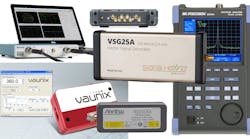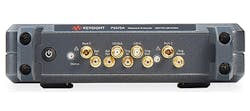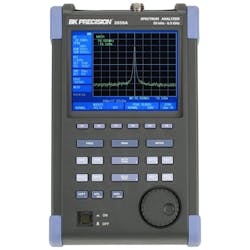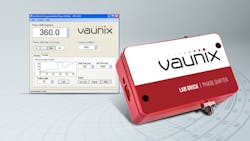Download this article in PDF format.
Microwave test equipment is gaining in power even as instruments are shrinking in size. Portable spectrum analyzers and oscilloscopes, for example, were once typified by carrying handles and lightweight battery packs; now they include a Universal Serial Bus (USB) for connection to a PC. In combination with available software, modern RF/microwave instruments are making it possible to pack a laboratory worth of measurement capability in a suitcase, and bring high-frequency measurements into the field without losing too much of the power of larger benchtop or rack-mount instruments.
The proliferation of USB RF/microwave test instruments over the last few years has been phenomenal, to the point that almost any measurement function can be contained within a pocket-sized package. Although they still require additional software and computing capability, like a laptop PC, such measuring instruments are every bit equal to the tasks of generating and analyzing signals through the RF and lower-microwave frequency ranges.
However, such equipment still lacks in performance compared to full-sized rack-mount and benchtop full-sized test instruments at higher microwave and millimeter-wave (mmWave) frequencies—but they are gaining. Although coaxial connectors are available through mmWave frequencies, just interconnections based on waveguide (when required) can be larger than one of today’s USB RF/microwave test instruments.
Almost any RF/microwave measurement function is currently available as a USB instrument, perhaps if only with less bandwidth and frequency range than full-sized test instruments. Even a line of USB vector network analyzers (VNAs), such as the TTR500 series from Tektronix, provide cost-effective, simple-to-perform two-port vector network measurements with a USB connection and control of a laptop computer (Fig. 1).
1. Two-port VNAs in the TTR500 series can make S-parameter measurements across a 122-dB dynamic range from 100 kHz to 6 GHz. (Courtesy of Tektronix Inc.)
These pocket-sized instruments can make two-path S-parameter measurements across a 122-dB dynamic range for signals from 100 kHz to 6 GHz. The analyzers are designed to work with the company’s VectorVu-PC measurement software and feature an application programming interface (API) for Microsoft Windows operating-system (OS) software.
A company long associated with VNAs, first as Hewlett-Packard Co., then Agilent Technologies, and now as Keysight Technologies, has shown it’s quite capable at fitting an effective VNA architecture into a USB-powered enclosure. The firm’s Streamline Series of P937XA model two-port USB VNAs, although a fraction the size of a benchtop VNA (Fig. 2), sacrifice little in measurement capability and accuracy across a total frequency range of 300 kHz to 26.5 GHz.
2. The Streamline Series of USB VNAs covers a total measurement range of 300 kHz to 26.5 GHz. (Courtesy of Keysight Technologies)
A total of six models provide frequency coverage of 300 kHz to 4.5, 6.5 9.0, 14.0, 20.0, and 26.5 GHz with ±1-Hz frequency accuracy. They also achieve dynamic range of better than 114 dB at 9 GHz and better than 110 dB at 20 GHz. These lightweight little VNAs offer fine frequency tuning, with resolution of 1 Hz to 2.5 GHz, 3 Hz to 10 GHz, 6 Hz to 20 GHz, and 12 Hz above 20 GHz. As small as the USB package, the architecture can be expanded to accommodate four-port VNA measurements.
Not to forget one of the “workhorse” instruments at lower frequencies, Keysight also offers its model U2702A 200-MHz USB modular oscilloscope; in appearance, it looks very similar to the USB VNAs. The oscilloscope works with test software running on a PC with the Microsoft Windows 7 or newer OS, using the computer’s display screen to show measured results and the graphical user interface (GUI) for setting up measurements. With 32 Mpoints of memory and a 1-Gsample/s sampling rate, the little USB oscilloscope can hold its own with much larger scopes built for the same test bandwidth.
When it comes to USB and VNAs, few companies can match the choice of instruments offered by Copper Mountain Technologies and its one-, two-, and four-port USB VNAs for testing through 20 GHz. With instruments for both 75- and 50-Ω measurements, USB VNAs like the 50-Ω model C4420 perform all four S-parameter measurements with measurement speeds as fast as 10 µs/point and dynamic range as wide as 152 dB. To add to its power, the firm also offers versions of its CobaltFx Frequency Extension System that can bring two- and four-port 9- and 20-GHz USB VNAs much higher in frequency—as high as 110 GHz when needed!
Packing It In
Although many of the latest USB RF/microwave test instruments rely on a USB-connected computer to show test results, some high-frequency USB instruments truly pack everything into one package, such as the compact handheld spectrum analyzers from B&K Precision Corp. The firm’s 2650A series of analyzers cover frequency ranges of 50 kHz to 3.3 GHz or 8.5 GHz, with a tracking generator available for models through 3.3 GHz.
In addition to working with a USB computer, B&K’s spectrum analyzers have a built-in color liquid-crystal-display (LCD) screen with 640- × 480-pixel resolution and they can operate for as long as 4 h on a battery charge for ease of portable measurements (Fig. 3). They weigh only 4 lbs. (1.8 kg) with the rechargeable lithium-ion battery and deliver measurement capabilities that compare favorably with much larger benchtop spectrum analyzers. Specs include SSB phase noise of −90 dBc at 100 kHz offset from the carrier, displayed average noise level (DANL) of −127 dBm, and fast sweep speeds for performing quick scans for noise and interference.
3. Some USB instruments, such as these handheld spectrum analyzers, can display test results on their own screens in addition to a connected PC. (Courtesy of B&K Precision Corp.)
Among the smallest of USB RF/microwave test instruments, the MA24108A (10 MHz to 8 GHz), MA24118A (10 MHz to 18 GHz), and MA24126A (10 MHz to 26 GHz) true-RMS power sensors from Anritsu Co. have block diagrams that resemble a measurement bench, with two diode-based signal paths orchestrated by a microcontroller even while they are contained in a housing that fits into a shirt pocket (Fig. 4). These tiny measurement tools can be calibrated with traceability to the National Institute of Standards and Technology (NIST). They are complete power measurement systems, with calibration factors and linearity and temperature correction data stored within the sensor.
4. These power sensors are capable of NIST-traceable measurements at frequencies as high as 26 GHz. (Courtesy of Anritsu Co.)
The two diode detector paths provide measurement options within these test systems, allowing the microcontroller to choose the signal path that maintains the detector diodes within their square-law regions or power level to achieve the highest measurement accuracy. The power sensors can be used with a USB connection to a PC or with selected company handheld power meters. They can make true RMS power measurements for CW, multitone, and digitally modulated signals over a better than 60-dB dynamic range.
Anritsu also offers its ShockLine MS46122B series of USB VNAs with three two-port models covering bandwidths of 1 MHz to 8.0, 20.0, and 43.5 GHz. These compact USB-controlled instruments boast better than 100-dB dynamic ranges and measurement speeds of better than 130 µs/point, making them well-suited for passive 5G component measurements.
Generating Signals
Lest it seem that all USB instruments are for analyzing or measuring RF/microwave signal characteristics, signal generators such as the LSG and LMS series Lab Brick instruments from Vaunix Technology Corp. provide swept-frequency and CW output signals through 20 GHz with very good spectral purity, including low phase noise. The LSG series of signal generators are designed for swept-frequency signal generation, while the LMS series instruments provide frequency switching speeds as fast as 100 ms with 100-Hz frequency resolution. They are capable of phase-continuous sweeps and can work with internal or external pulse modulation.
In addition to its compact signal generators, Vaunix has added its LPS line of phase shifters in the same compact housing, with mini-b USB connector and SMA RF connectors (Fig. 5). Models are available for frequency ranges of 1 to 2 GHz, 2 to 4 GHz, 4 to 8 GHz, and 8 to 12 GHz, each with 1-deg. phase-adjustment resolution and ±2.5-deg. phase-adjustment accuracy across a full 360-deg. phase-adjustment range. These phase shifters, which are handy little devices for performing measurements on phased-array antennas and systems as well as phase-sensitive coaxial cables, maintain healthy test-signal power with typical insertion loss of only 5 to 6 dB throughout their frequency ranges.
5. Phase shifters such as these operate under USB control at frequencies to 12 GHz. (Courtesy of Vaunix Technology Corp.)
For those in need of complex modulated test signals, the model VSG-25A from Signal Hound truly houses large capabilities in a small package (Fig. 6). This is a 12-b in-phase/quadrature (I/Q) baseband arbitrary waveform generator that can generate analog, digital, and arbitrary output waveforms. It can be clocked from 54 kHz to 180 MHz to produce an output frequency range of 100 MHz to 2.5 GHz with better than 1-Hz frequency resolution and better than ±5 ppm/year frequency accuracy.
6. This arbitrary waveform generator fits on a “USB stick” but provides complex modulated signals through 2.5 GHz. (Courtesy of Signal Hound)
The VSG-25A boasts a 100-MHz modulation bandwidth and includes the software and API needed to generate any number of advanced modulation formats, such as binary phase-shift keying (BPSK), quadrature phase-shift keying (QPSK), 16-state phase-shift keying, and Gaussian minimum shift keying (GMSK). It can also deliver output signals with more than 1000 simultaneous tones as well as pulse widths from 6 ns to 25 ms with on/off pulse ratios of better than 45 dB and typically 60 dB.
The USB signal generator is capable of output signal levels from −40 to +10 dBm. It features excellent spectrum purity, with SSB phase noise of typically −88 dBc/Hz offset 1 kHz from a 1-GHz carrier and −132 dBc/Hz offset 1 MHz from the same carrier. It measures just 5.50 × 2.25 × 1.0 in. and weighs a mere 5 oz. The signal generator is designed for use with Microsoft Windows 7.0 or later OS and a USB 2.0 port.
Packing a receiver into the same basic format, the firm also offers the model USB-SA44B measuring receiver and spectrum analyzer in the same little package. It covers a range of 1 Hz to 4.4 GHz. It’s capable of a DANL of −124 dBm/Hz at the lowest frequencies, as good as −158 dBm/Hz at 1 GHz with a built-in preamplifier, and −128 dBm/Hz or better at the highest frequencies with no preamplification. The company’s Spike software is compatible with Microsoft Windows 7.0 or higher OS and allows the spectrum analyzer to operate as a real-time spectrum analyzer (RTSA).
For even higher frequencies (through 26.5 GHz), Telemakus LLC offers a line of frequency-synthesized signal sources in bands such as 700 to 1000 MHz, 1.8 to 2.7 GHz, 9.3 to 10.2 GHz, and 24.0 to 26.5 GHz. The company has extensive lines of RF/microwave instruments with USB ports, including RF/microwave switches through 6 GHz, digital attenuators through 8 GHz, and power sensors covering a frequency range as wide as 50 MHz to 8 GHz. The compact model TED8000-40 power sensor, for example, covers a 40-dB measurement range with 0.5-dB accuracy from 50 MHz to 8 GHz (Fig. 7).
7. One of the earliest suppliers of USB frequency synthesizers is now offering models through 26.5 GHz. (Courtesy of Telemakus LLC)
It should be noted that this is just a sampling of the number of RF/microwave USB test instruments currently on the market—that number continues to climb and with more extending higher in frequency. These handy test tools are a fraction of the size and costs of benchtop measuring instruments, but for those with a PC available, they sacrifice little in performance and accuracy.








